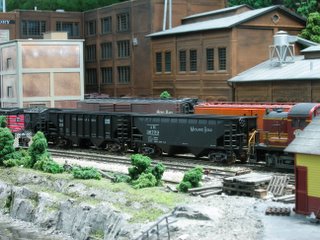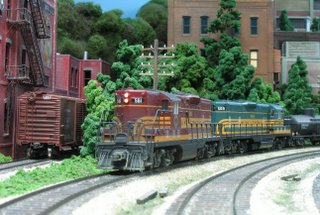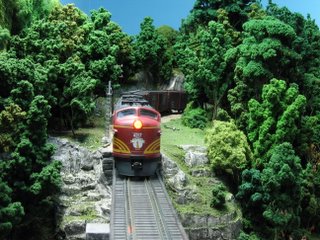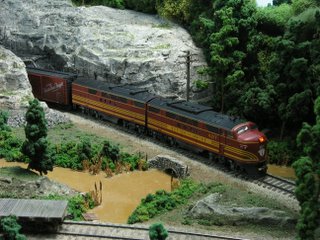 Railfans around North Dover and environs were on their telephones hustling groups of friends trackside when they got wind of two unusual cars in the consist of train PM6 that would arrive town shortly...sometime within the half hour.
Railfans around North Dover and environs were on their telephones hustling groups of friends trackside when they got wind of two unusual cars in the consist of train PM6 that would arrive town shortly...sometime within the half hour.
Mike Hamer received the call from his railfanning buddy, Theo van Vliet. Theo was down at the station and overheard the stationmaster say that train PM6, a hotshot freight from Portland to Mechanicville had in its consist a long cut of hopper cars which contained two rather distinct "specimens" in the block.
When Hamer heard the origin of the two unique hoppers, he quickly grabbed his camera and headed out the door to his car, a brand new black and white '58 Chevy.
 "Theo", Hamer shouted over the phone. "How about you stay in town near the station and yard tracks and I'll hustle out to the New England River Bridge. What time did the train depart Rigby Yard?"
"Theo", Hamer shouted over the phone. "How about you stay in town near the station and yard tracks and I'll hustle out to the New England River Bridge. What time did the train depart Rigby Yard?"
"No need to worry," Theo responded. "He left Rigby a while back and the stationmaster here tells us he should be a good 20 minutes out. You should just have enough time to make it."
Yes, Mike just managed to make it to the inbound side of the New England River. He could hear the train whistle blow above the combined rumble of EMD and Alco units as the canyon walls reverberated at Haney Cut. Knowing that a slow order restriction was in effect at the bridge, he was able to set up his tripod in time to capture the three units assigned to this lengthy train, two GP7's and an RS3. Mike spotted fellow railfan, Bill Meek, on the other side of the river. "Good," thought Mike, "I got a shot of the units and hopefully Bill got a shot of the hoppers."
 Hustling to put his equipment away, Hamer knew that he could make it to Marshall Cut in time for a second photograph as a slow order restriction would be in effect through the cut as well. After parking in the lot at Conley Lumber and Coal, he quickly climbed a small ridge in time to shoot the train as it exited the inbound gateway to Marshall Cut. He found it unusual to see the third locomotive in forward position rather than reversed as is normal practise. In his days of railfanning Mike has learned to expect the unexpected!
Hustling to put his equipment away, Hamer knew that he could make it to Marshall Cut in time for a second photograph as a slow order restriction would be in effect through the cut as well. After parking in the lot at Conley Lumber and Coal, he quickly climbed a small ridge in time to shoot the train as it exited the inbound gateway to Marshall Cut. He found it unusual to see the third locomotive in forward position rather than reversed as is normal practise. In his days of railfanning Mike has learned to expect the unexpected!
 Meanwhile, Theo decided to drive out to Boundary Road to snap a shot before heading back to the station. Theo had eaten quite a hefty lunch and decided to wait it out in his car. He was startled to see the train arrive the crossing so quickly that he didn't have time to park his car and set up his equipment.
Meanwhile, Theo decided to drive out to Boundary Road to snap a shot before heading back to the station. Theo had eaten quite a hefty lunch and decided to wait it out in his car. He was startled to see the train arrive the crossing so quickly that he didn't have time to park his car and set up his equipment.
He managed to open his car door and put one foot on the asphalt and lens a picture of one of the desired hopper cars as the train crawled into yard limits across Boundary Road.
 After capturing the shot at Boundary Road, Theo turned his car around and headed back to the station where he knew the train would be kept busy conducting exchanges in North Dover. This would afford him ample time to shoot the hoppers and perhaps get a shot of the diesels before heading back home for lunch.
After capturing the shot at Boundary Road, Theo turned his car around and headed back to the station where he knew the train would be kept busy conducting exchanges in North Dover. This would afford him ample time to shoot the hoppers and perhaps get a shot of the diesels before heading back home for lunch.
After parking his car, Theo walked behind the freight depot located across the team track from the station. He waited patiently for his shot while the drops and lifts were taking place. Shortly, Theo was rewarded with an image of both "targets" with the massive Phillips Furniture Factory acting as a backdrop.
 He then walked back across the parking lot where he took his final set of images capturing the lead unit, GP7 #1568 with its sister #1566 and RS3 #1519.
He then walked back across the parking lot where he took his final set of images capturing the lead unit, GP7 #1568 with its sister #1566 and RS3 #1519.
Later that afternoon, Theo, Bill and Mike gathered to discuss the photographs they had taken. All were pretty excited to get their rolls of film developed to place their images in their railfan scrapbooks.
Editor's note: The Midland Road car travelled all the way from Tony Koester's Alleghany Midland Railroad and the Virginian and Ohio made it to North Dover from Allan McLellan's V&O Railroad.
Cheers, Mike Hamer
Check out my other weblog which details my train operating round robin group at www.fridaynightgroup.blogspot.com
 The Maine Central has been a railroad that has long intrigued me. The builders of this interesting transportation system faced many obstacles as they attempted to connect the remote areas of Maine to the rest of the world. When I think of the MEC in a geographical sense, I envision mountains, forests and rivers.
The Maine Central has been a railroad that has long intrigued me. The builders of this interesting transportation system faced many obstacles as they attempted to connect the remote areas of Maine to the rest of the world. When I think of the MEC in a geographical sense, I envision mountains, forests and rivers.
Indeed, Maine is a lumber state, dotted with countless papermills. This has enabled me the opportunity to run "unit trains" on my small, yet busy, 11x13 layout. Wanting to operate such a train of similar cars, I was faced with the choice of hauling either pulpwood or tanker traffic in long drags behind lashups of maroon & gold and green & gold Maine Central motive power. My decision was made easy when Proto2000 came out with their highly detailed tankcar kits. I chose to operate a unit tanker train which I have nicknamed, "The Oil Can". (Yes, I patiently constructed thirty of these kits - in an assembly line approach - to have sufficient cars for "the look" of a unit train and to have enough on the sidings in town for exchange purposes!)
 The Oil Can hauls empty tanker consists from the interior of Maine (where they fuelled the many paper mills) to my fictitious town of North Dover. The Maine Central is granted traffic rights in town where empties are exchanged for loads. In reality, the Maine Central conducted interchange with the Boston and Maine much further to the north. However, by naming my town North Dover (and not the real town of Dover), I provided myself with the opportunity to "imagineer" the exchange of traffic taking place further to the south.
The Oil Can hauls empty tanker consists from the interior of Maine (where they fuelled the many paper mills) to my fictitious town of North Dover. The Maine Central is granted traffic rights in town where empties are exchanged for loads. In reality, the Maine Central conducted interchange with the Boston and Maine much further to the north. However, by naming my town North Dover (and not the real town of Dover), I provided myself with the opportunity to "imagineer" the exchange of traffic taking place further to the south.
The handsome EMD inspired livery of the Maine Central makes it a perfect cousin to the Boston and Maine as the photographs will attest!
I consider the Maine Central to be a survivor, and indeed it has to this day...as a major player in my model railroad world of New England.
Cheers, Mike Hamer
Check out my other weblog which details my train operating round robin group at www.fridaynightgroup.blogspot.com
 Many of my friends in Canada have asked how I became a fan of the Boston and Maine Railroad. The story begins back in 1996 when I first began the planning phase for my future railroad. My good friend, Trevor Marshall, was modelling the TH&B (Toronto, Hamilton and Buffalo) Railroad and I rather liked the appearance of his diesel locomotives in their cream and maroon livery. Trevor, sensing my interest in this handsome diesel paint scheme told me of a few (remotely) similar paint applications on other railroads...one being the B&M. I immediately recognized the beautiful Maroon and Deluxe Gold colours of the B&M diesels from my childhood days when my family would take camping trips from our home in Montreal to New England. The dye was cast!
Many of my friends in Canada have asked how I became a fan of the Boston and Maine Railroad. The story begins back in 1996 when I first began the planning phase for my future railroad. My good friend, Trevor Marshall, was modelling the TH&B (Toronto, Hamilton and Buffalo) Railroad and I rather liked the appearance of his diesel locomotives in their cream and maroon livery. Trevor, sensing my interest in this handsome diesel paint scheme told me of a few (remotely) similar paint applications on other railroads...one being the B&M. I immediately recognized the beautiful Maroon and Deluxe Gold colours of the B&M diesels from my childhood days when my family would take camping trips from our home in Montreal to New England. The dye was cast!
I was rather new to model railroading at this time. Trevor loaned me some books focussing on railroading in the Northeast. I was hooked! My model railroad would depict the Boston and Maine as it existed when I was a child. I later chose to model a precise day, my date of birth...May 27th, 1958. This provided me with the liberty to run diesels in the earlier black scheme, the lovely maroon and gold scheme...and, if I wanted, the new McGinnis Bluebird livery.
So, there you have it. I certainly owe a great deal of gratitude to Trevor for leading me (astray) away from the typical, but n ice, paint schemes of the CN and CP railroads that most of my friends in Canada select for their choice for model railroad operations. Indeed, the pictures speak for themselves!
ice, paint schemes of the CN and CP railroads that most of my friends in Canada select for their choice for model railroad operations. Indeed, the pictures speak for themselves!
Editor's note: Trevor later sold all his TH&B equipment and went on to model the B&M in its steam days...so I wonder who influenced who?! Ahh, model railroading is fun!
Trevor's account of this story from way back in time is a little different..."Truth be told, Angus Palmer and I were already modelling the TH&B, and that was enough people in Ottawa for me. So I was hoping to suggest something else to throw you off the scent - I like being "different". Well, little did I know that in helping you define your layout, I'd say "heck, this is the railroad that I should be modelling!" 'course, this doesn't explain why I'm working in On2 now..."
 Ahh, how the passage of time changes our perspective on things!
Ahh, how the passage of time changes our perspective on things!
Cheers, Mike Hamer
Check out my other weblog which details my train operating round robin group at http://www.fridaynightgroup.blogspot.com/
 Railfans around North Dover and environs were on their telephones hustling groups of friends trackside when they got wind of two unusual cars in the consist of train PM6 that would arrive town shortly...sometime within the half hour.
Railfans around North Dover and environs were on their telephones hustling groups of friends trackside when they got wind of two unusual cars in the consist of train PM6 that would arrive town shortly...sometime within the half hour. "Theo", Hamer shouted over the phone. "How about you stay in town near the station and yard tracks and I'll hustle out to the New England River Bridge. What time did the train depart Rigby Yard?"
"Theo", Hamer shouted over the phone. "How about you stay in town near the station and yard tracks and I'll hustle out to the New England River Bridge. What time did the train depart Rigby Yard?" Hustling to put his equipment away, Hamer knew that he could make it to Marshall Cut in time for a second photograph as a slow order restriction would be in effect through the cut as well. After parking in the lot at Conley Lumber and Coal, he quickly climbed a small ridge in time to shoot the train as it exited the inbound gateway to Marshall Cut. He found it unusual to see the third locomotive in forward position rather than reversed as is normal practise. In his days of railfanning Mike has learned to expect the unexpected!
Hustling to put his equipment away, Hamer knew that he could make it to Marshall Cut in time for a second photograph as a slow order restriction would be in effect through the cut as well. After parking in the lot at Conley Lumber and Coal, he quickly climbed a small ridge in time to shoot the train as it exited the inbound gateway to Marshall Cut. He found it unusual to see the third locomotive in forward position rather than reversed as is normal practise. In his days of railfanning Mike has learned to expect the unexpected! Meanwhile, Theo decided to drive out to Boundary Road to snap a shot before heading back to the station. Theo had eaten quite a hefty lunch and decided to wait it out in his car. He was startled to see the train arrive the crossing so quickly that he didn't have time to park his car and set up his equipment.
Meanwhile, Theo decided to drive out to Boundary Road to snap a shot before heading back to the station. Theo had eaten quite a hefty lunch and decided to wait it out in his car. He was startled to see the train arrive the crossing so quickly that he didn't have time to park his car and set up his equipment. After capturing the shot at Boundary Road, Theo turned his car around and headed back to the station where he knew the train would be kept busy conducting exchanges in North Dover. This would afford him ample time to shoot the hoppers and perhaps get a shot of the diesels before heading back home for lunch.
After capturing the shot at Boundary Road, Theo turned his car around and headed back to the station where he knew the train would be kept busy conducting exchanges in North Dover. This would afford him ample time to shoot the hoppers and perhaps get a shot of the diesels before heading back home for lunch. He then walked back across the parking lot where he took his final set of images capturing the lead unit, GP7 #1568 with its sister #1566 and RS3 #1519.
He then walked back across the parking lot where he took his final set of images capturing the lead unit, GP7 #1568 with its sister #1566 and RS3 #1519.





